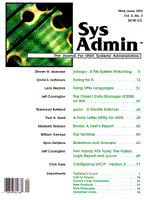
Sidebar: Memory Utilization and X
X applications are rarely less than 1 megabyte (MB), so the enemy of X Windows is low memory. When UNIX runs out of memory it begins to swap. Performance hits rock bottom and can even lead to a disaster such as broken pipes, or other system problems related to swapping portions of memory to disk. To reduce memory "paging," the system must be reconfigured to provide additional memory to X applications. To achieve this, you can simply increase the amount of physical memory installed in the computer. If the system is at its maximum installable memory, or if you can't spend the money on more memory, the sizes of the filesystems' buffers and other kernel data structures can be reduced. Remember, though, that reducing the buffers may also reduce disk performance. Another option is to alter the paging algorithm so that the system begins paging earlier. However, this alternative is only useful when the shortage of memory is relatively small. It's generally a good idea to install maximum RAM on the workstation where X will be operating. Intel workstations require at least 16 megabytes, but 32 megabytes is much better, and 64 megabytes is best. X Terminals require at least 4 megabytes of memory to process a reasonable number of X or Motif applications at a respectable speed. The only sure way to increase performance and cut memory consumption is to monitor the number of X applications that are executed by the users. Users may not need xclock, xeyes, or xload. The X Window system makes heavy use of buffers, generally opting for smaller (usually 128 bytes or less) rather than larger buffers. Most systems with X installed need to increase the value of NBLKn, as noted in the article. Running the Buffer Cache Subsystem Although disk I/O is not a primary concern with X Window performance, it does affect the performance of some X applications and is certainly a factor if the system is paging. When an I/O device request is made to a disk drive, the buffer cache system provides intermediate storage for information moving back and forth from the tracks of the disk. The buffer cache subsystem improves performance, which allows the I/O to make sizable ordered transfers, thereby minimizing seek time on the physical disk drive. It also allows programs to, whenever possible, read and write from cache memory instead of going to disk. The type of buffer cache subsystem differs among UNIX systems, but the basic concept is similar. The buffering cache subsystem is handled by the kernel, which allocates a portion of memory for buffer cache space. This portion of memory is configurable (see the NBUF parameter). The kernel then writes to memory as if writing to a file. At some point, the modified information is written to disk. The interval at which the information is written from memory to disk is configurable (see NAUTOUP). The size of the buffer cache is configurable in most UNIX operating systems. This is the major tuning parameter NBUF, and is the cause or cure for most system and disk I/O performance problems. A system with a lot of memory may have a large buffer cache system because the buffer cache may be a greater memory consumer than the kernel itself. So what is optimal buffer cache size for X Windows? You must compromise. The more memory you allocate to the buffer cache, the less you have for user programs and processes, and vice-versa. When buffer cache memory is reduced to make room for more or larger processes, disk I/O performance suffers.
|